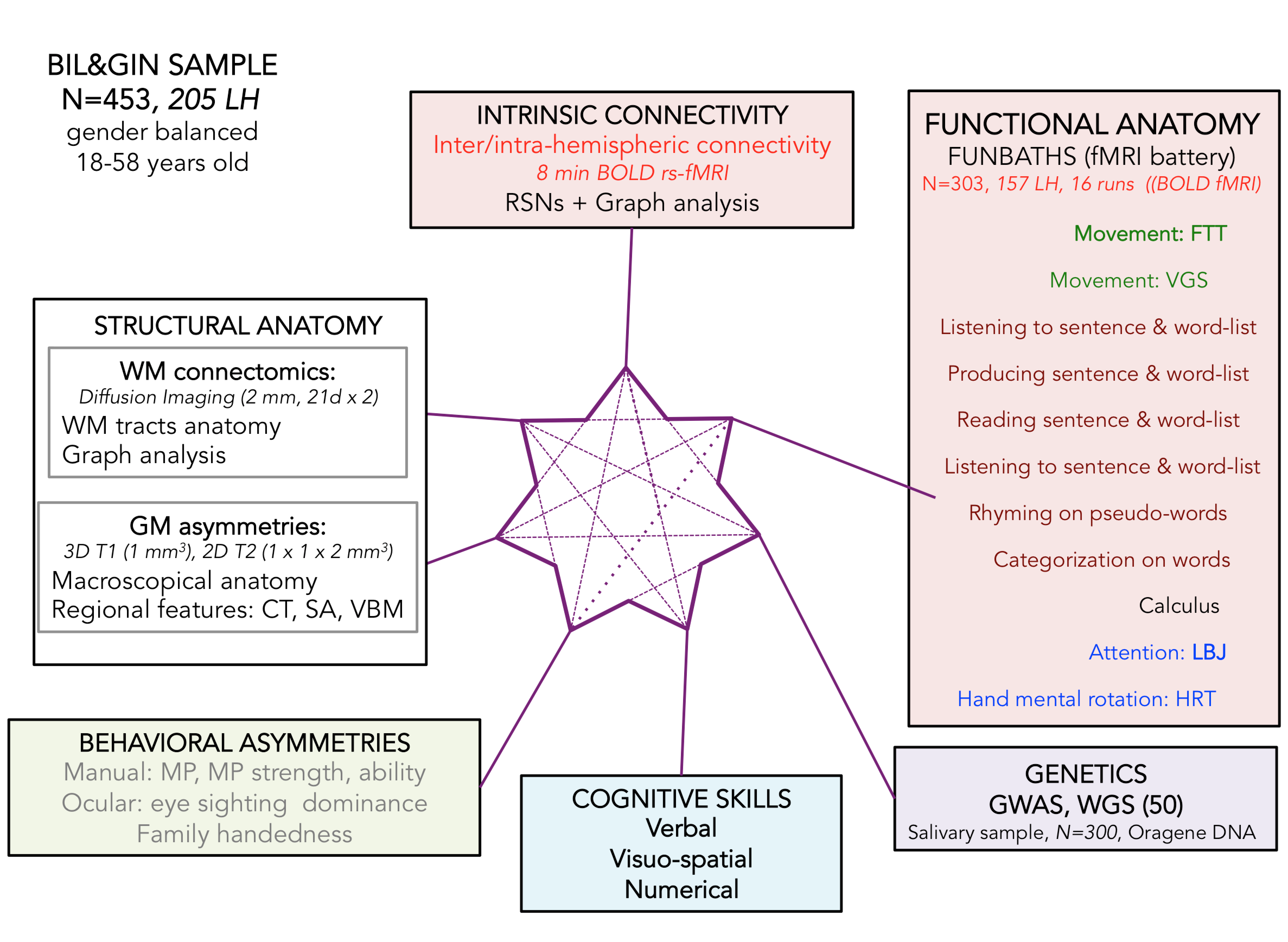What relationships with cognitive functioning ?
Hemispheric specialization (HS) is a relationship between a cognitive function and a set of cerebral structures of a given hemisphere. It includes both the hosting of specialized networks that have unique functional properties and mechanisms that allow inter-hemispheric coordination necessary for effective cognitive processing. The observations of patients with brain lesions since that of Broca in 1860 showed that the peculiarity of the SH of Humans is its low variability. For example more than 90% of the human beings have language functions in the left hemisphere and visuo-spatial attention by the right hemisphere. Studies of people with developmental diseases that cause language abnormalities such as dysphasia or dyslexia have shown that these subjects are less asymmetrical at the brain level. This is also the case in certain psychoses such as schizophrenia. But the origin and the factors of variability the HS remains poorly known in part because of its low variability.
Thématiques
- Langage : N. Tzourio-Mazoyer (contact), F. Crivello, I. Hesling, G. Jobard, M. Joliot, L. Labache, B. Mazoyer
- Attention : L. Zago (contact), N. Tzourio-Mazoyer
How does the hemispherical cerebral organization of cognitive functions take place? How does it happen that some people atypically shelter language in their right hemisphere? Is hemispheric lateralization necessary for optimal cerebral and cognitive functioning? If yes, for which functions? Are the subjects atypical for a given also have atypical organization of other cognitive networks? Are anatomical asymmetries markers of functional asymmetries? Can we determine non-invasively the lateralization for the language of an individual? Do atypical individuals have genetic features that explain their change in lateralization?
To answer these questions we combine anatomical, functional neuroimaging, connectivity measures, behavioral data, genotyping and databasing.
To relate the variability of cerebral lateralization of cognitive networks to demographic data such as age and sex, to behavioral lateralization such as manual preference, or to cognitive skills in the verbal, attentional, or numerical domains we acquired a database dedicated to the study of HS: the BIL&GIN.
The BIL&GIN was designed to answer the question of HS’ organizational rules by increasing the variability through the inclusion of a population balanced in gender and balanced in handedness, making it a unique database in the world. We choose anatomical and functional acquisition procedures adapted to the question posed and defined a battery of lateralized functional tasks (language, attention, motor skills, mental imagery and computation) in order to provide, for the first time, information about the relations between brain functional lateralization of these functions, behavioral lateralization, cognitive abilities, asymmetries of gray and white matter, and resting-state connectivity in the same participants. Genome-wide mapping was also performed in each individual from a saliva sample, including complete genome sequencing for individuals with atypical lateralization for speech as well as for typical control individuals.

This BIL&GIN data diagram shows how it can be used to analyze the multiple relationships between the salient features of HS, anatomical hemispheric characteristics, anatomical connectivity, resting connectivity (or intrinsic connectivity), functional asymmetries measured with Functional Resonance Imaging (fMRI) during a battery of cognitive tasks exploring lateralized cognitive functions, behavioral asymmetries, and cognitive skills of the participants. The sample was deliberately enriched with left-handers to obtain the statistical power needed to explore inter-individual variability. The saliva sample collected from each participant contributes to studies on the genetics of lateralization as well as to the projects of consortia of genetic neuroimaging.
This approach made it possible to revisit the old concepts on the HS: the example of left-handers.
Research with the BIL&GIN is ongoing, some within the GIN-IMN, others in collaboration with international teams.
As far as the genetic basis of language lateralization is concerned, we are members of the projet européen MULTI-LATERAL (Multi-level Integrative Analysis of Brain Lateralization for Language) coordinated by Clyde Francks Max Planck Institute in Nijmegen (The Netherlands) Flag-Era (Fabrice Crivello PI for GIN-IMN) on the genetics of the lateralization of the language.
BIL&GIN‘s genetic and neuroimaging data also enable the GIN-IMN to participate in international meta-analyzes and meta-databases conducted by major international genetic neuroimaging consortia such as CHARGE (coordonnated par Sudha Seshadri, Boston University) and ENIGMA (coordinated by Paul Thompson, University of Southern California).
The BIL&GIN data is shared with the international academic community on a collaborative basis.
Such collaborative projects are underway with Alan Evans (Montreal Neurological Institute), Daniele Marinazzo (Ghent University), and Michael Ewers (Munich University). Some data acquisition protocols of BIL&GIN were also shared with Manuel Carreiras (BCBL, San Sebastian) and Dorothy Bishop (Oxford University).
